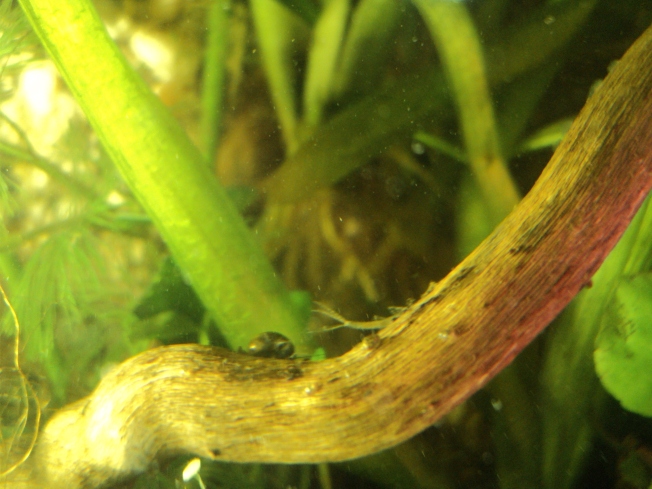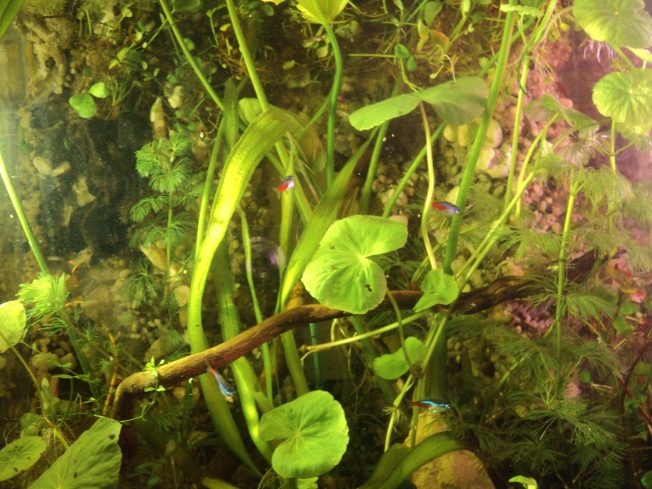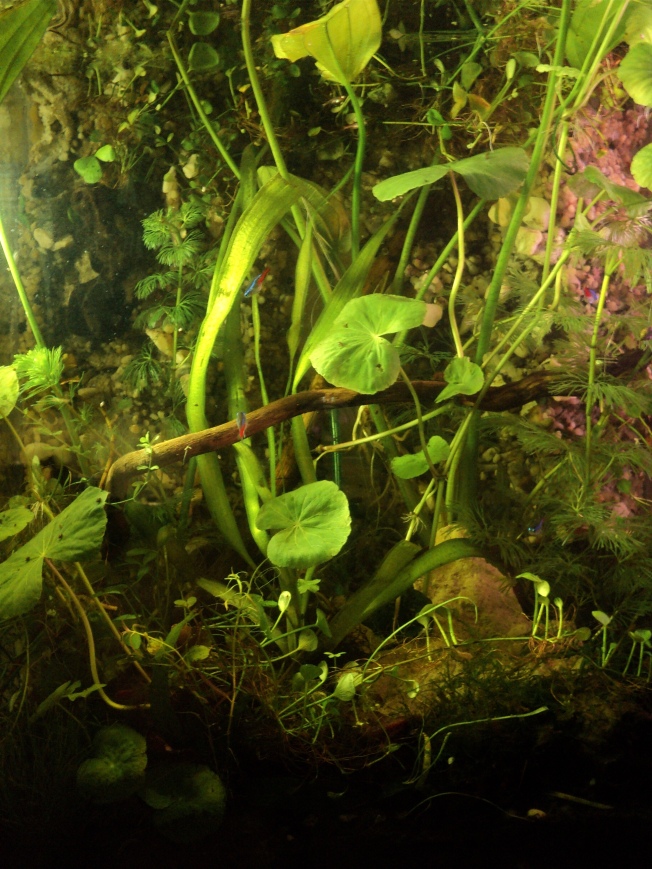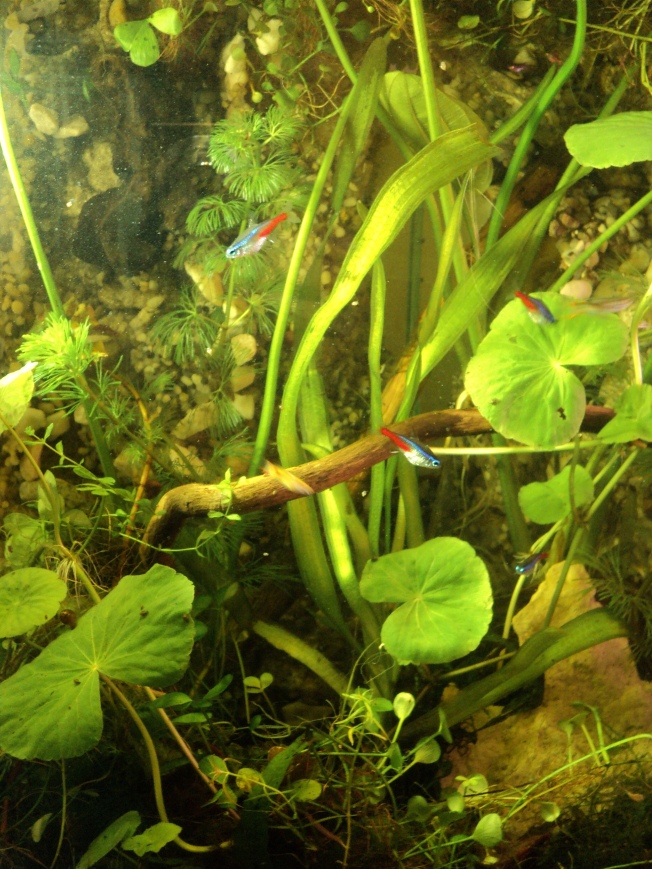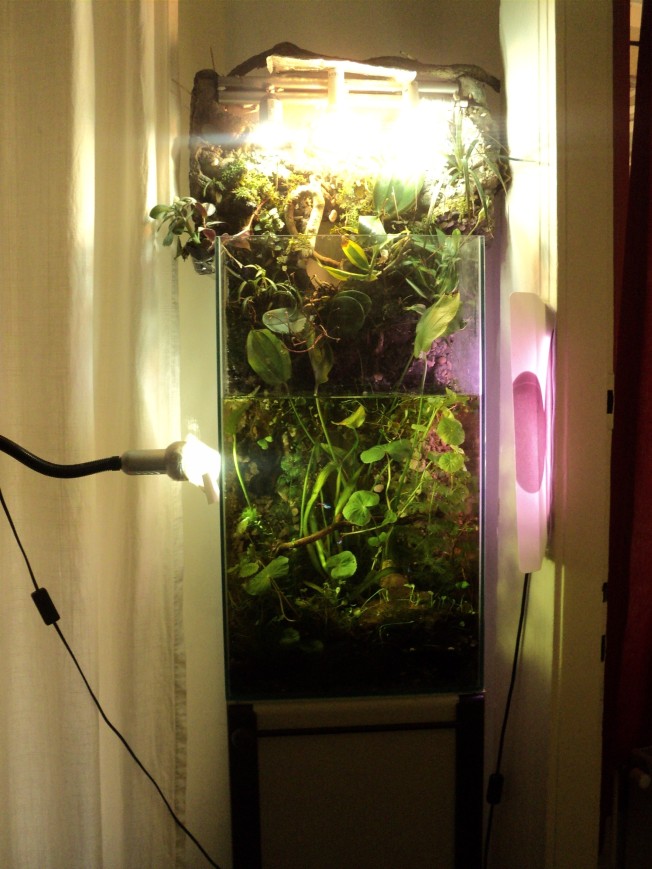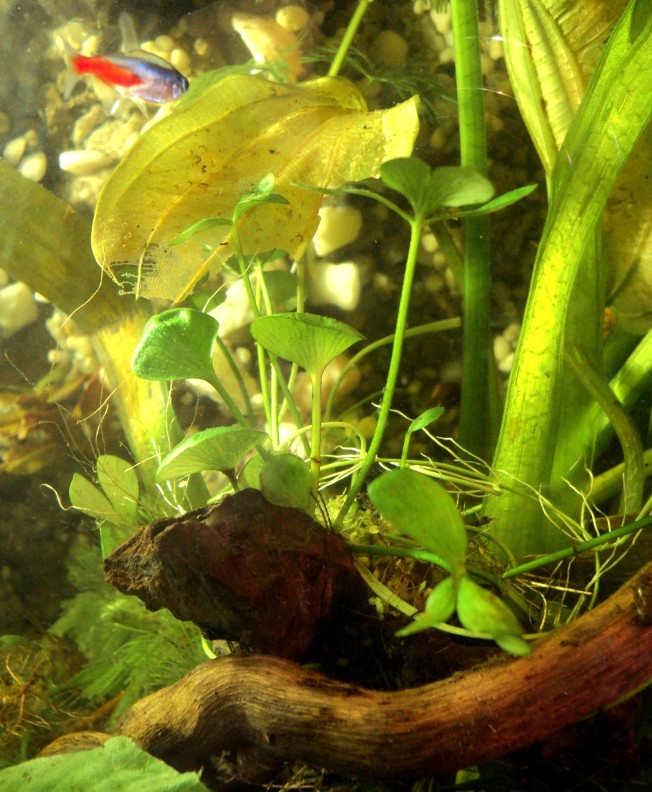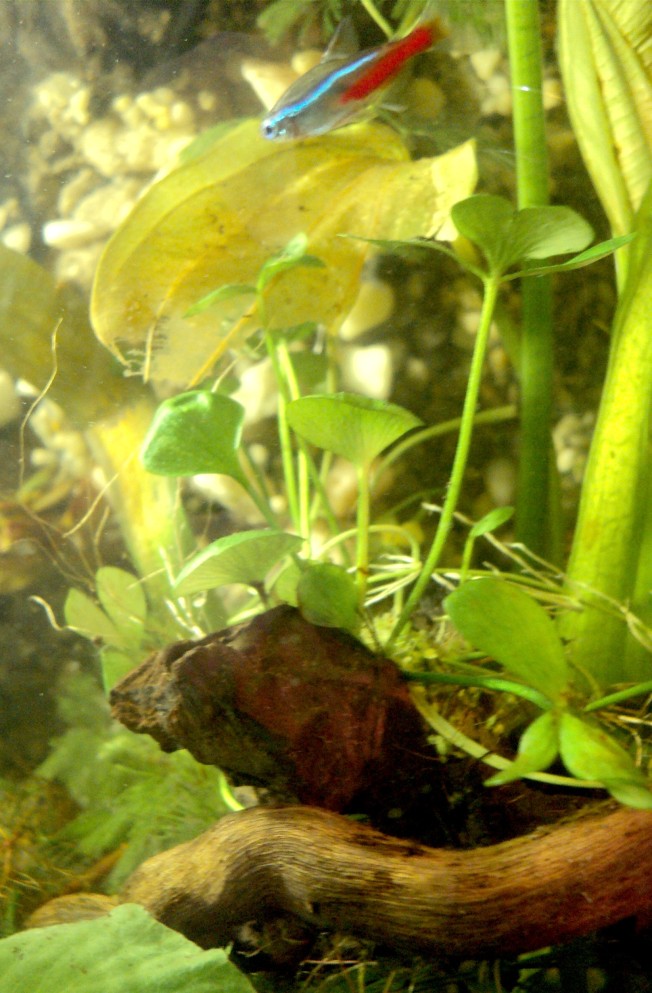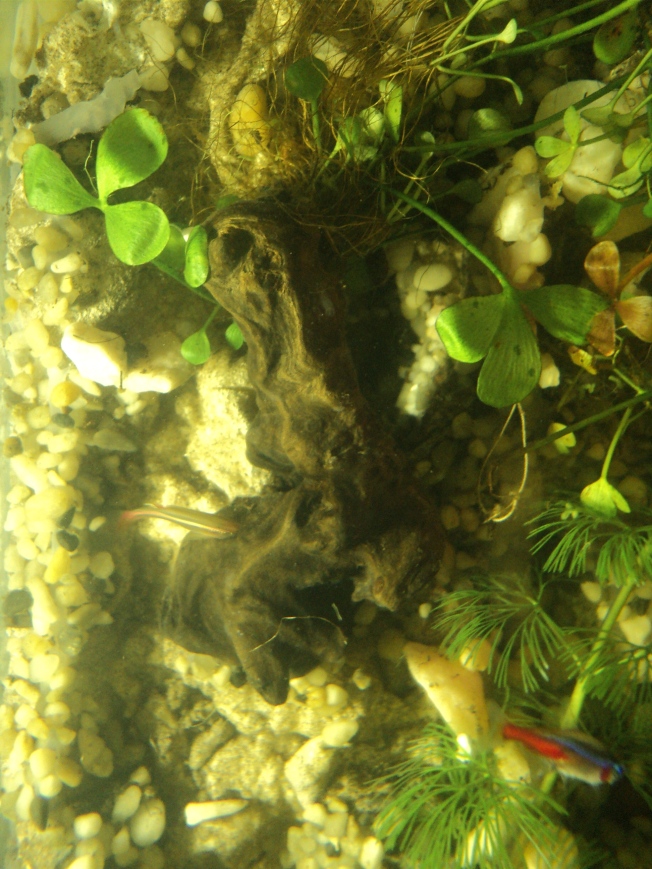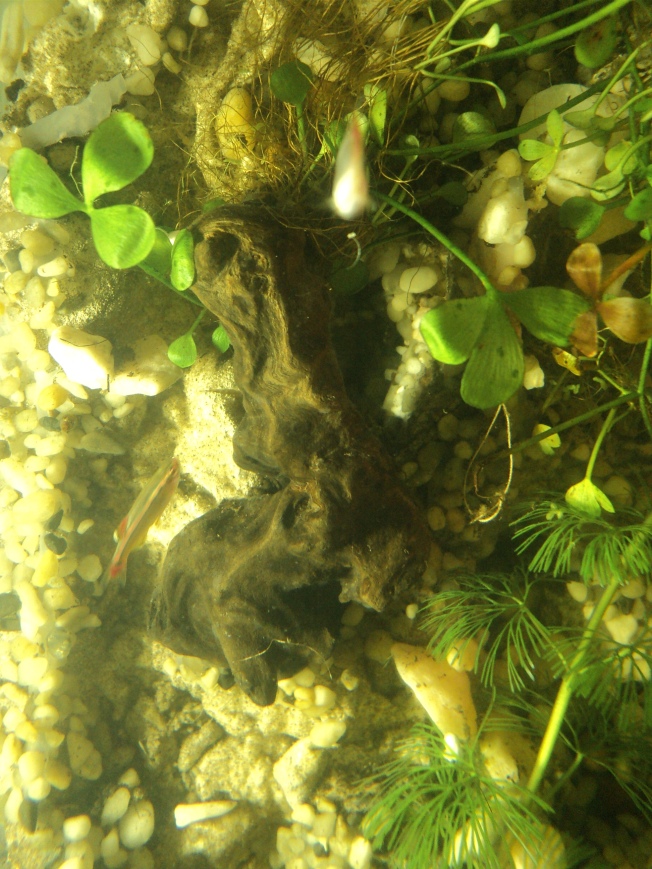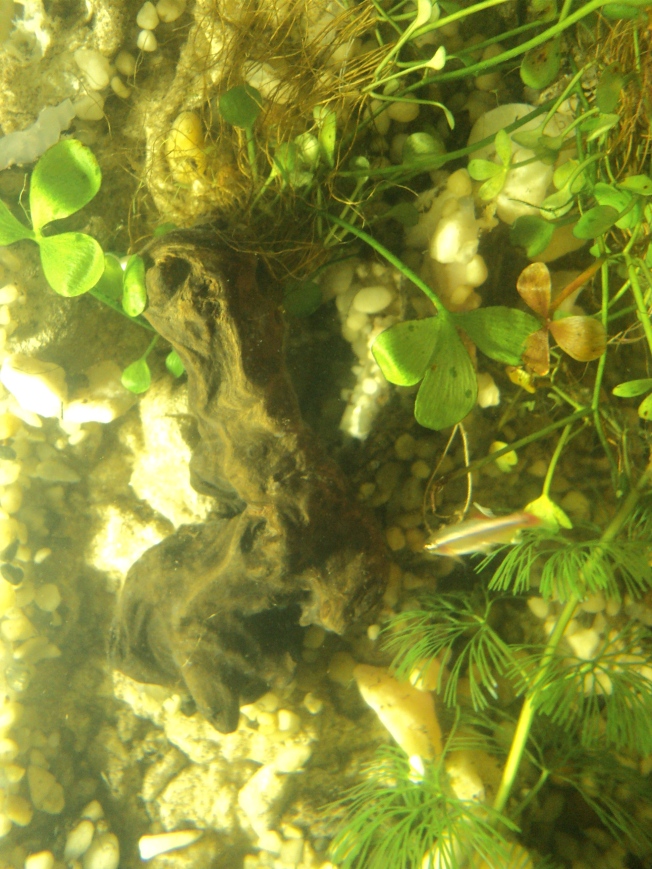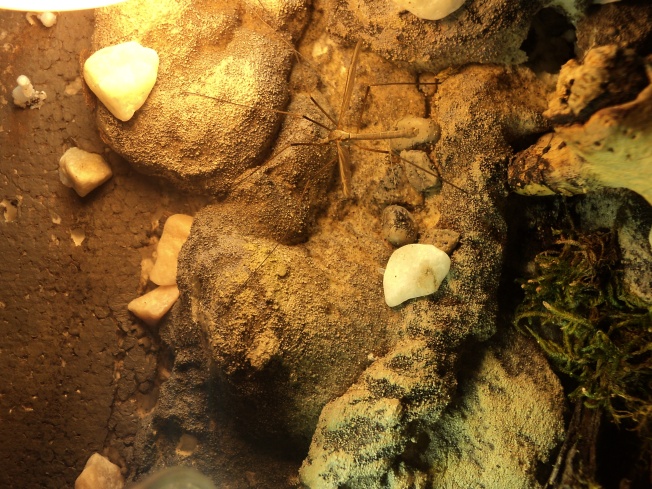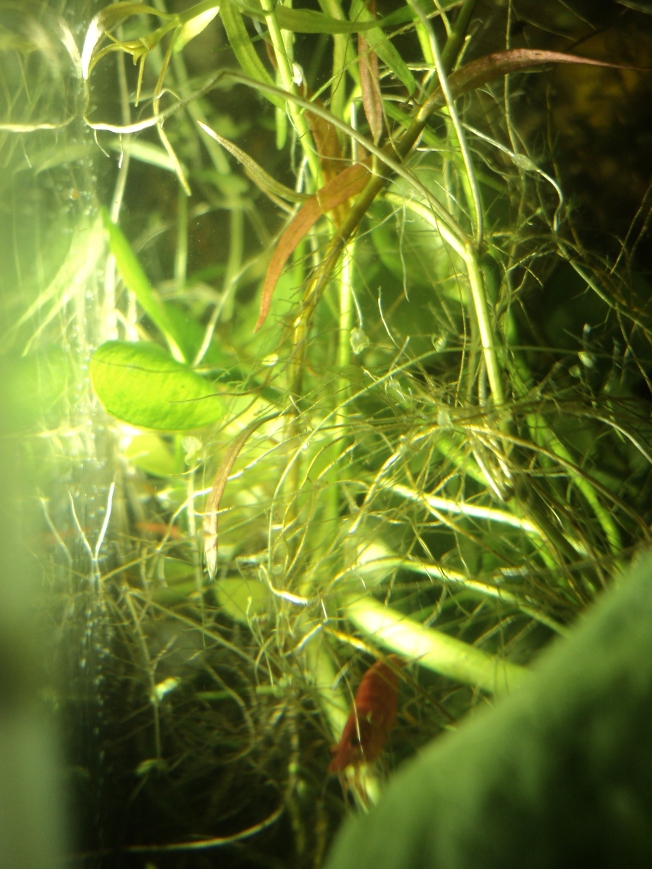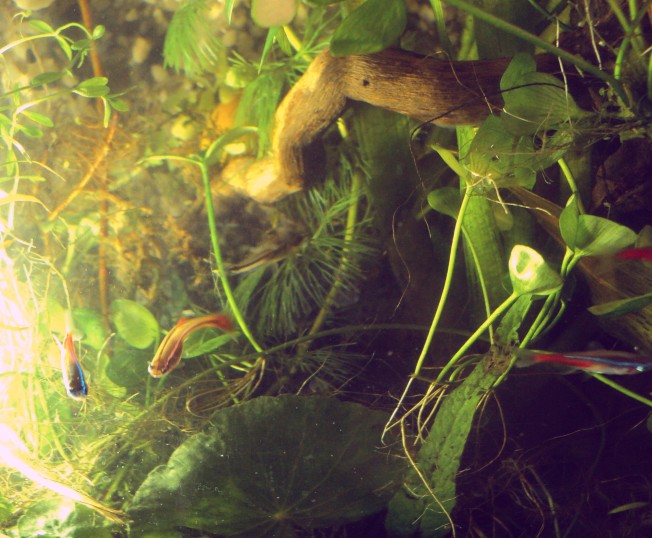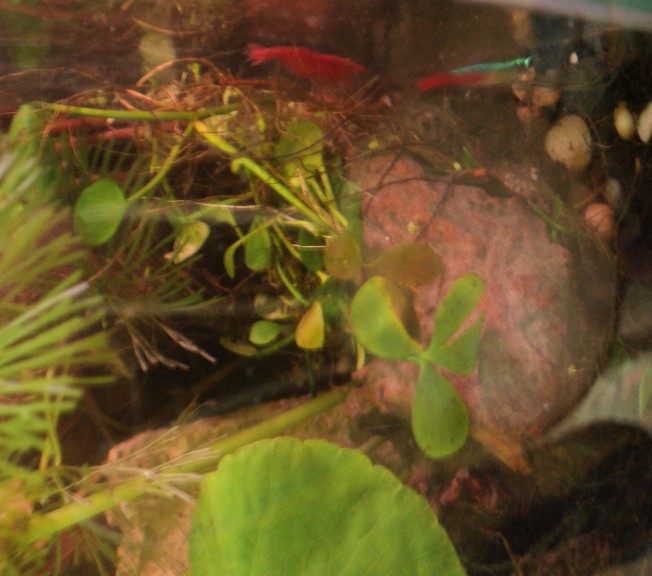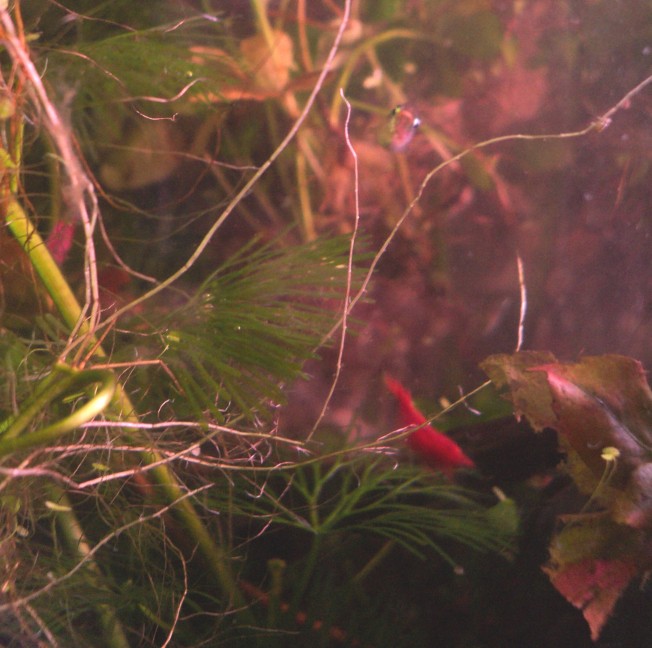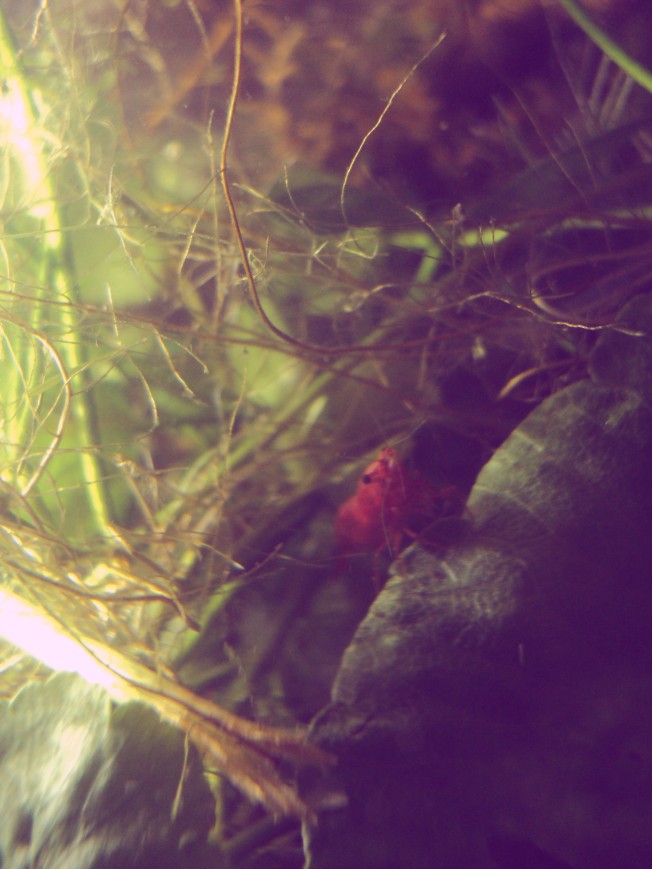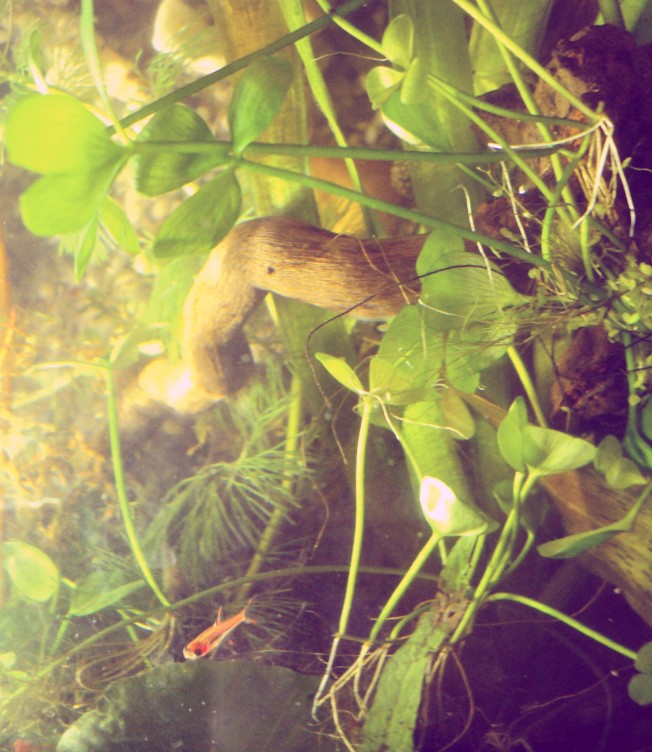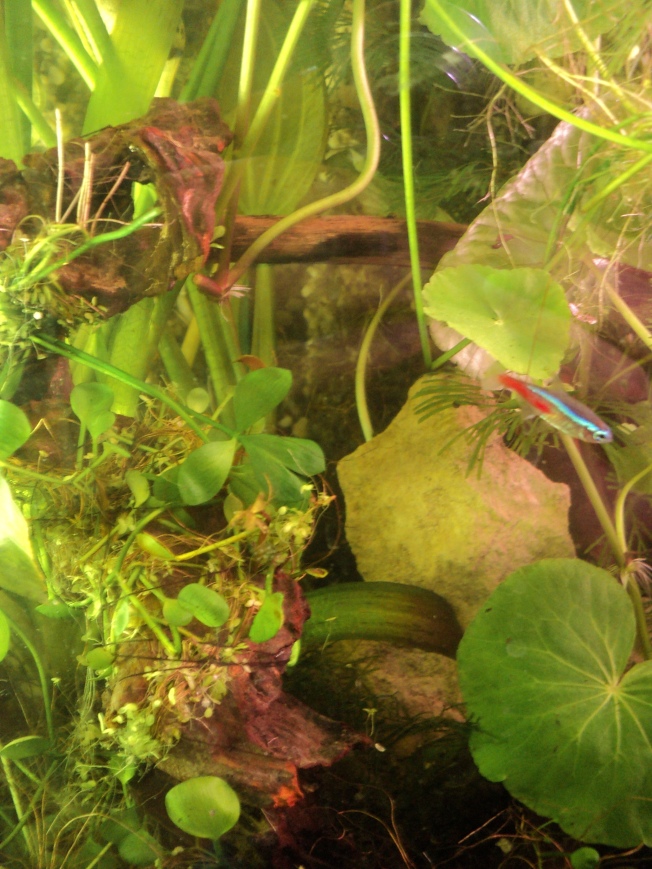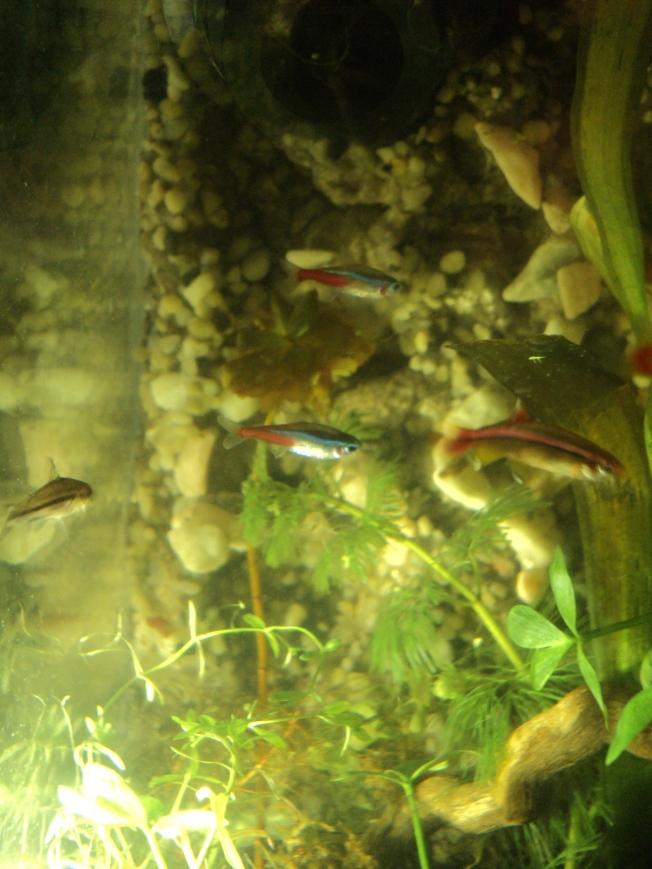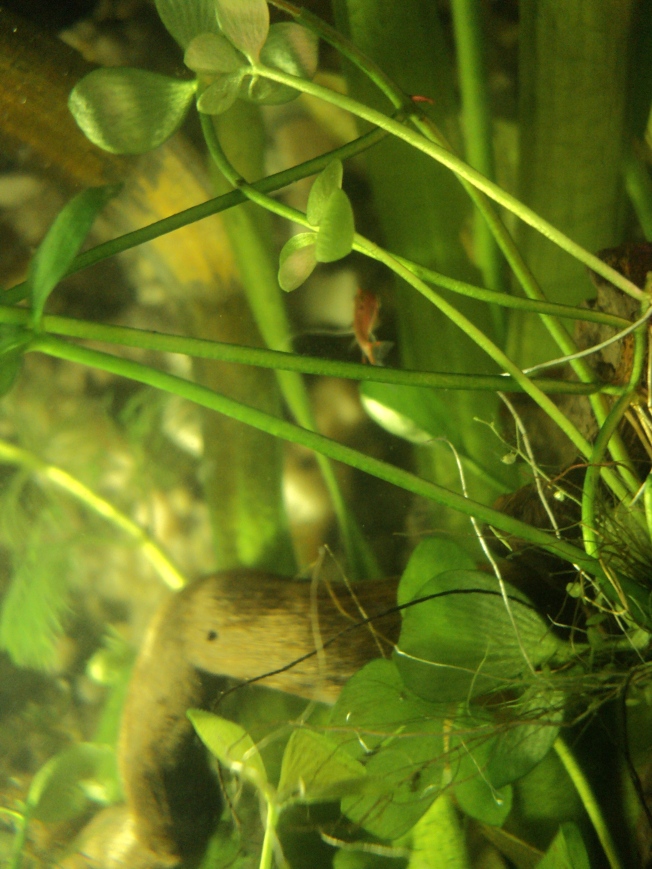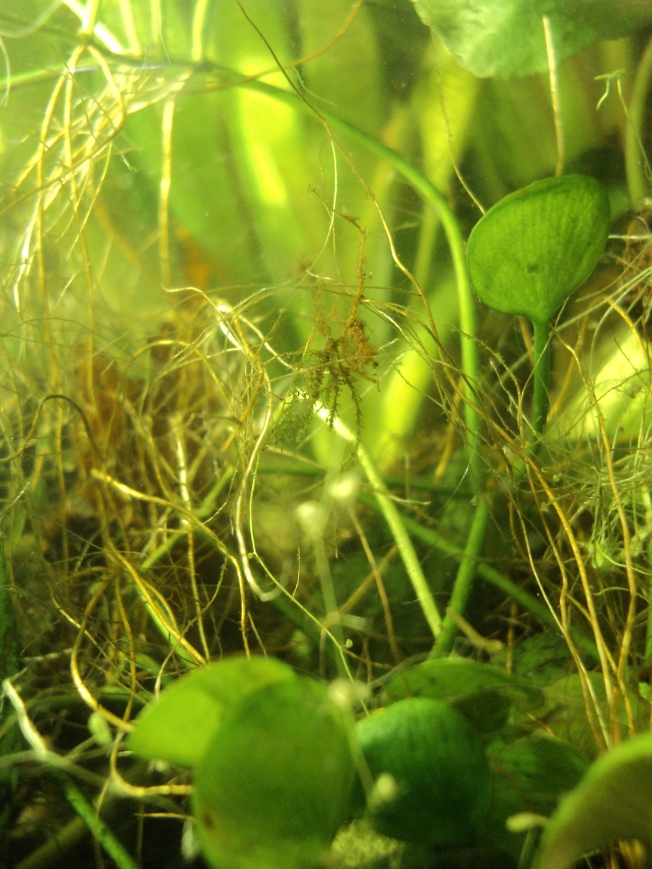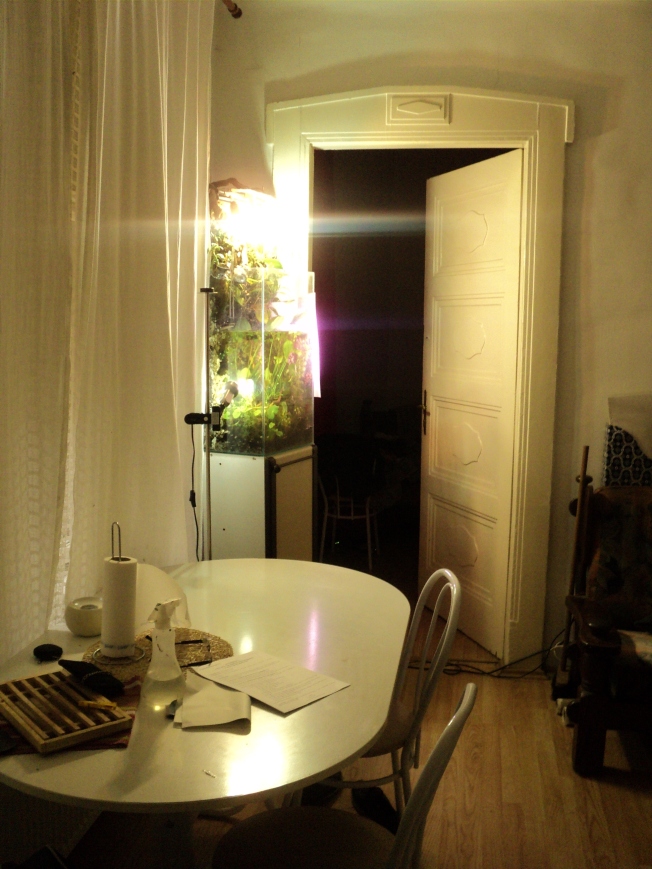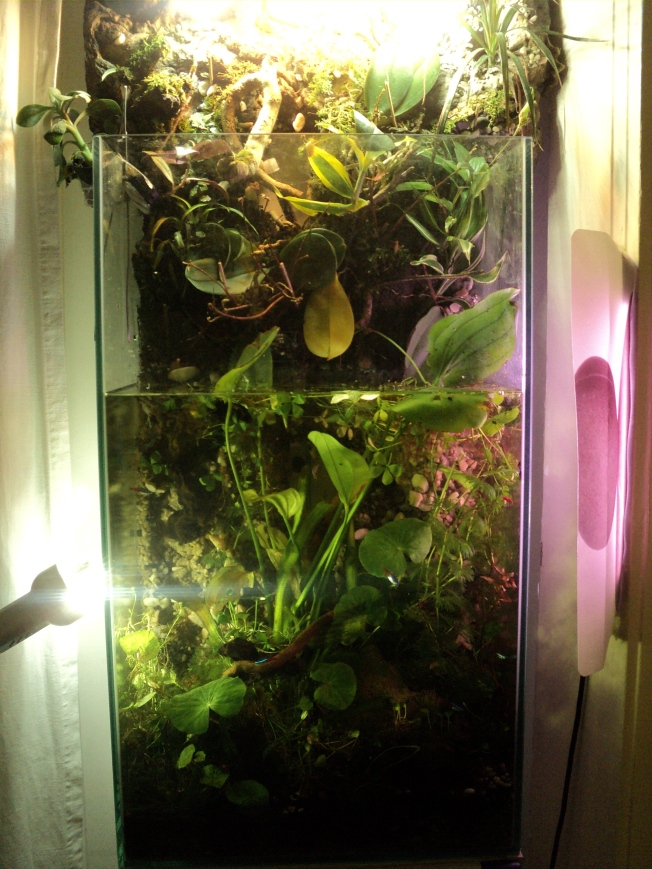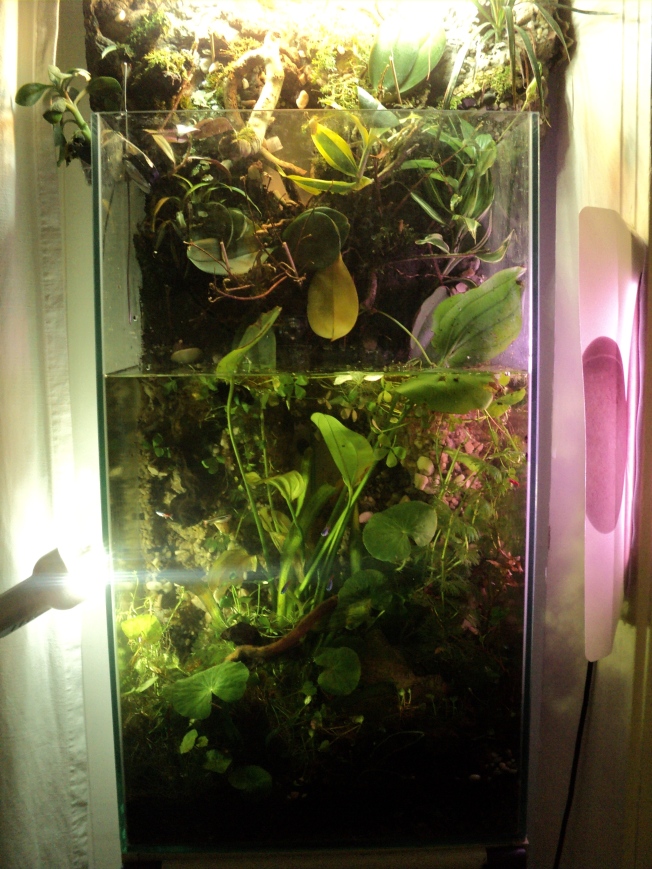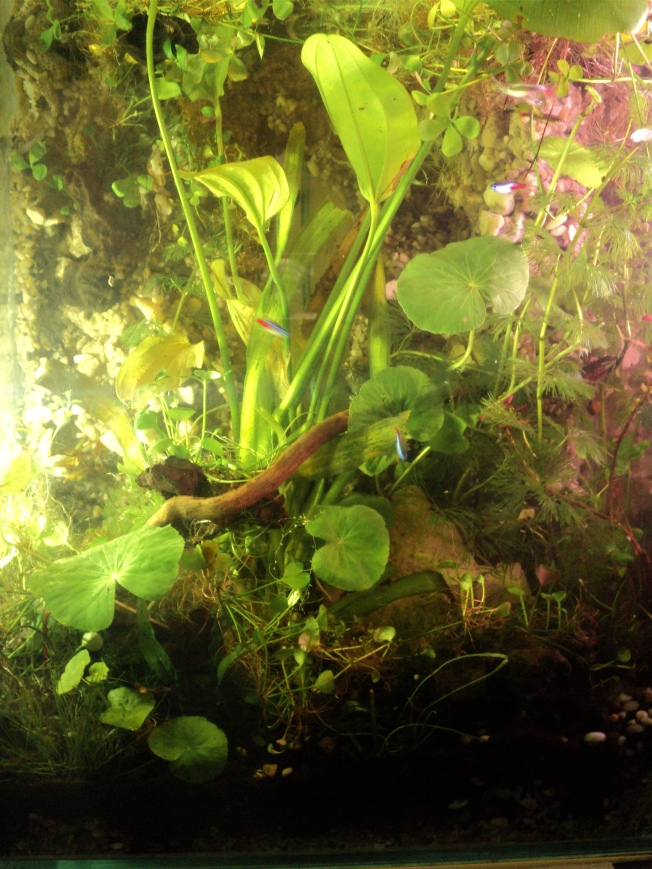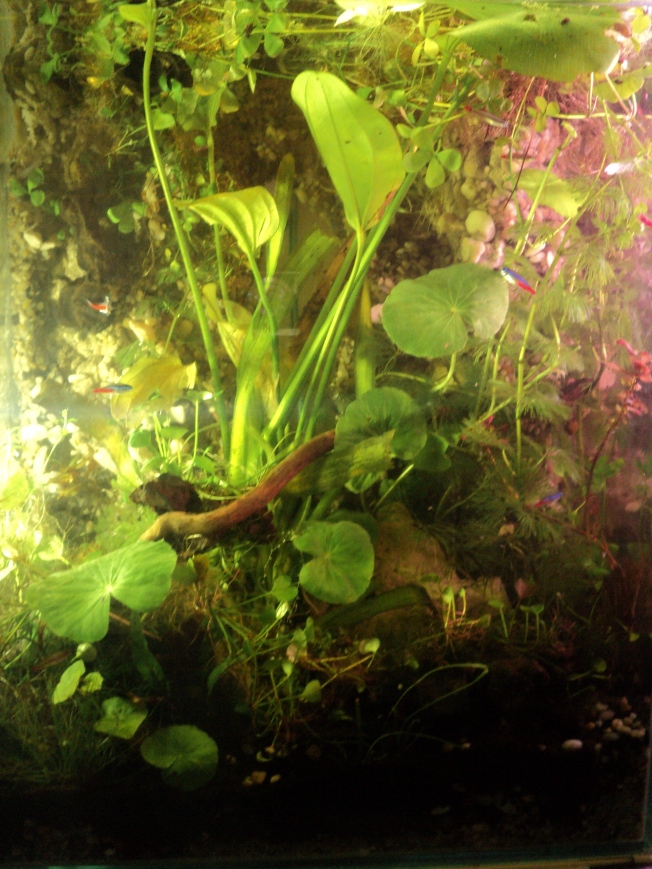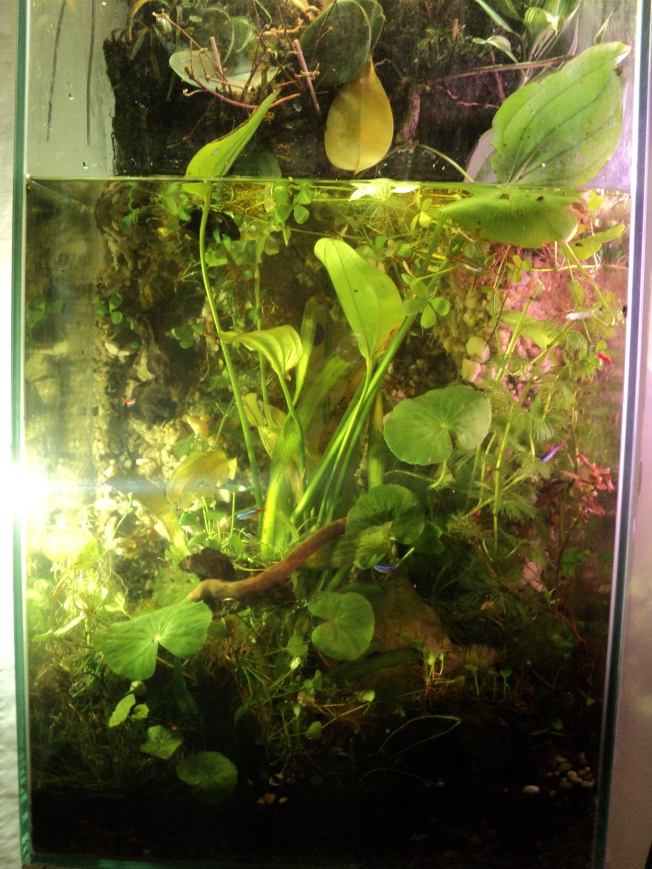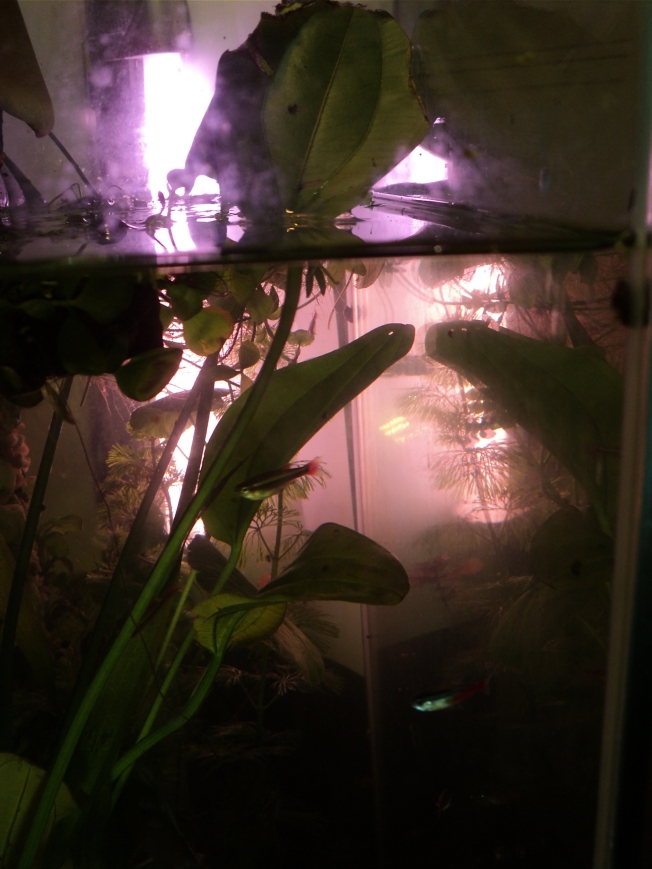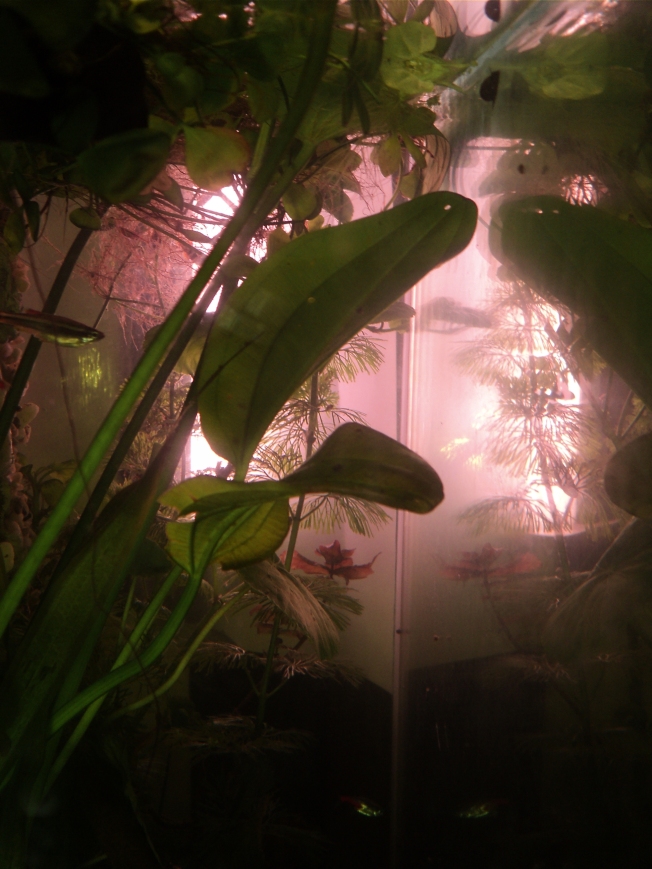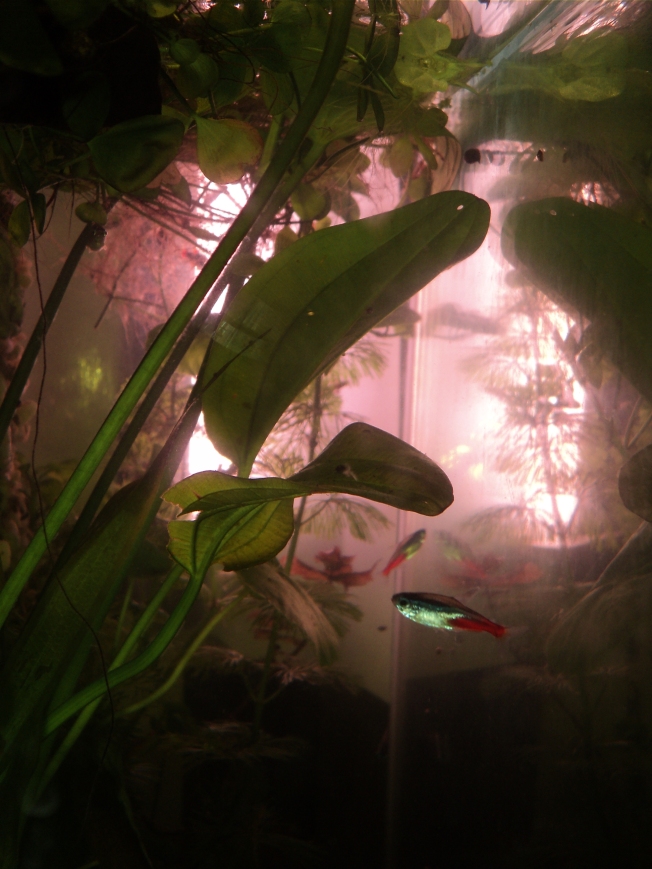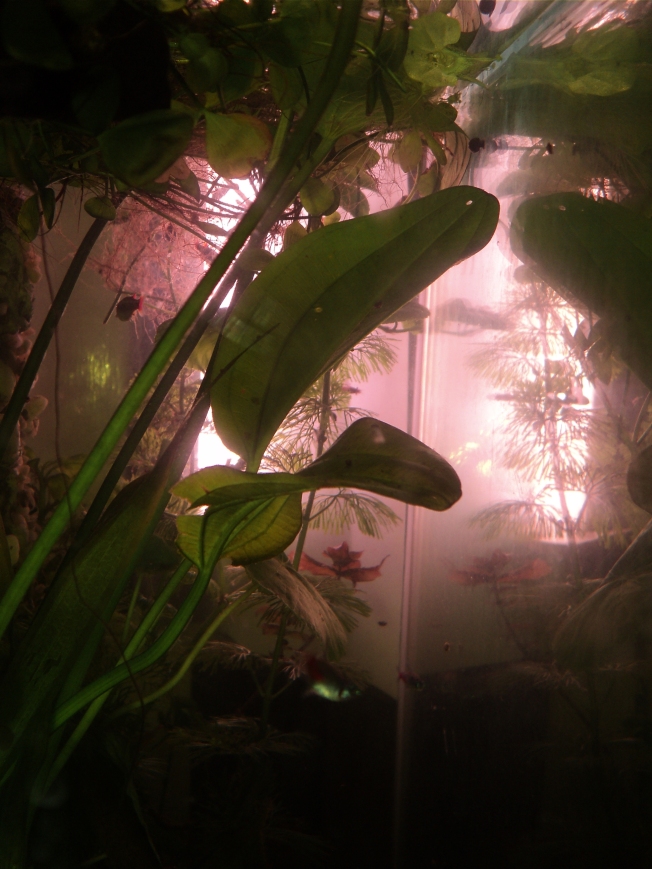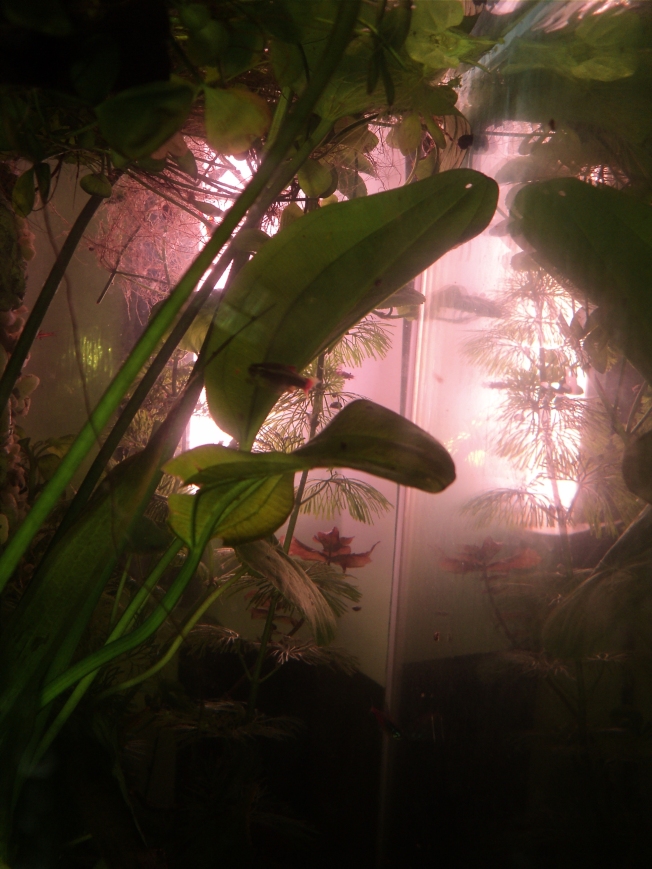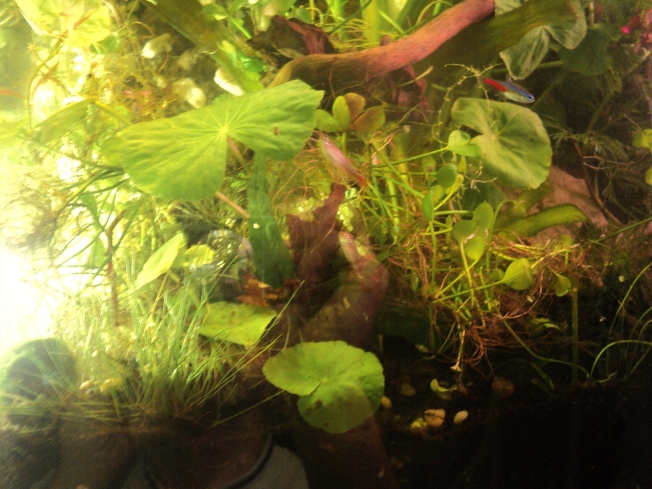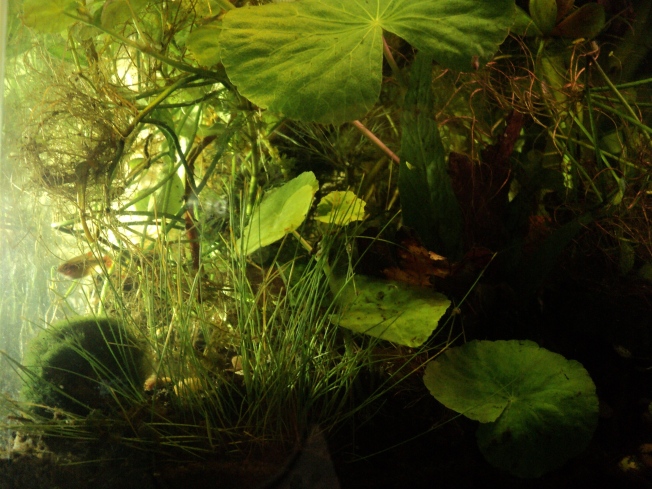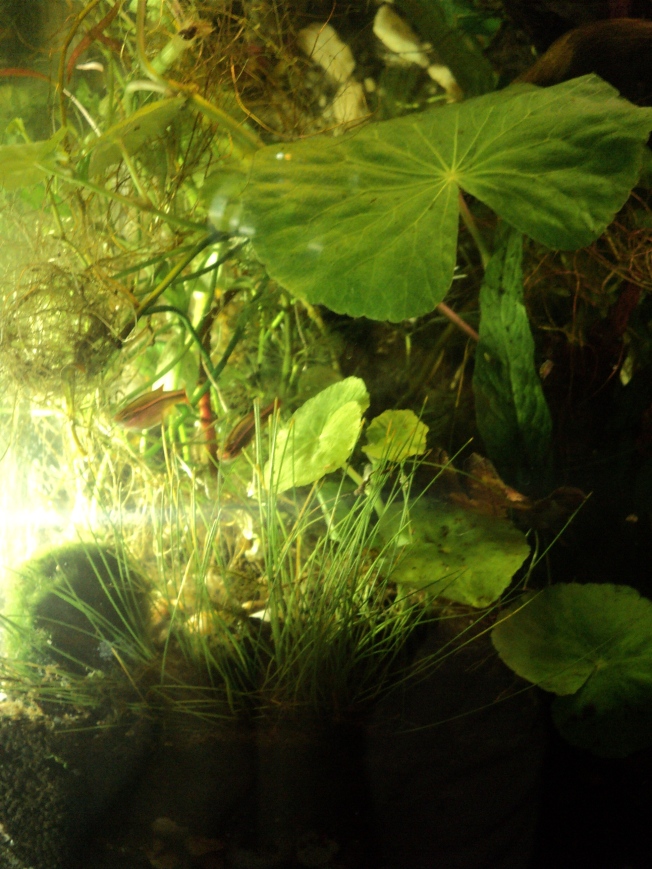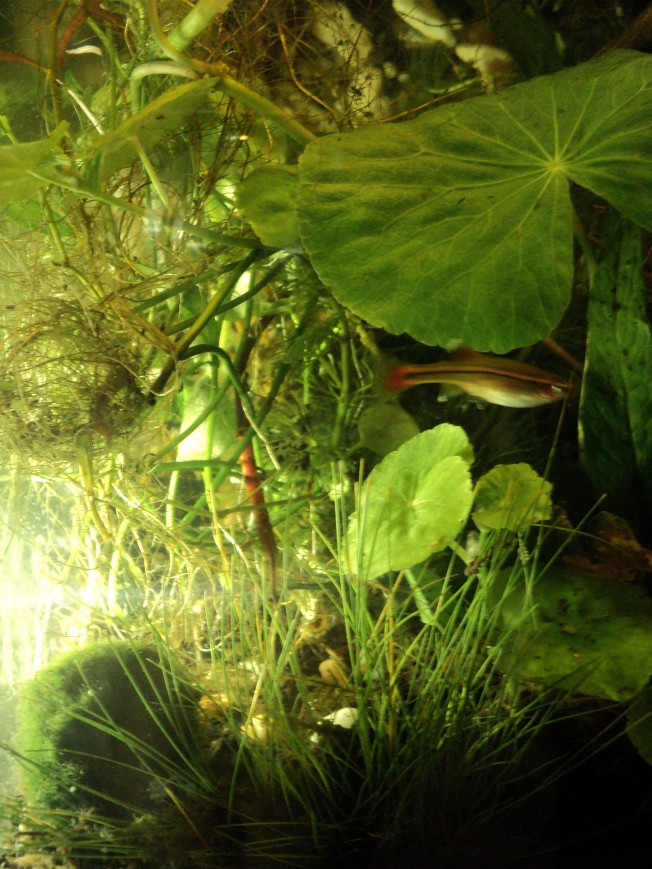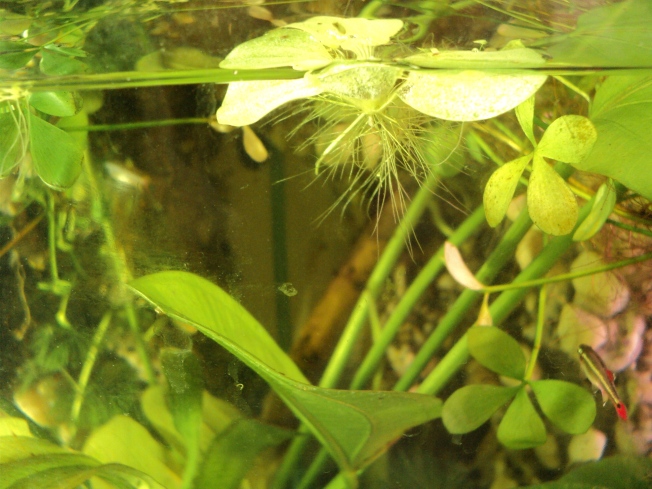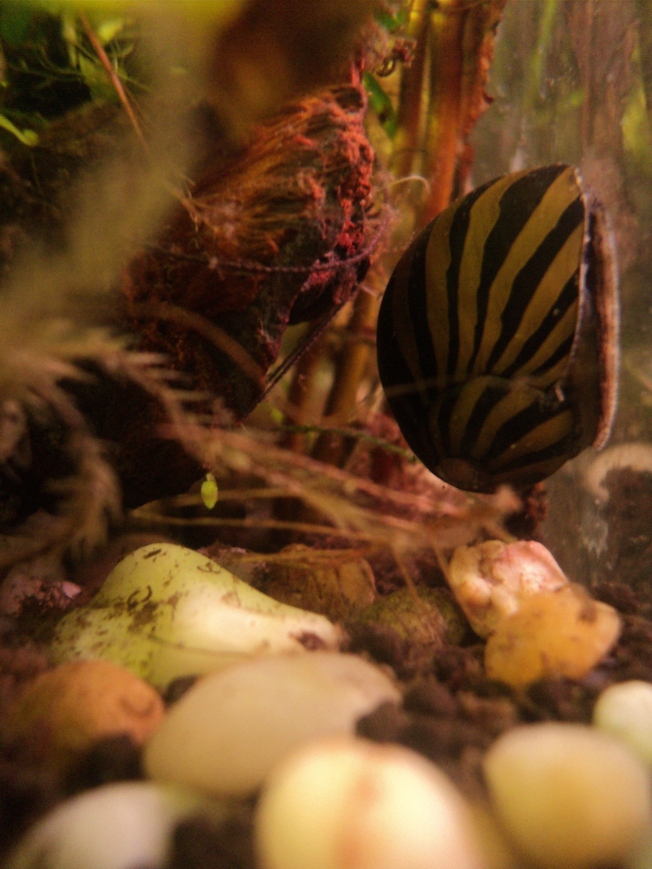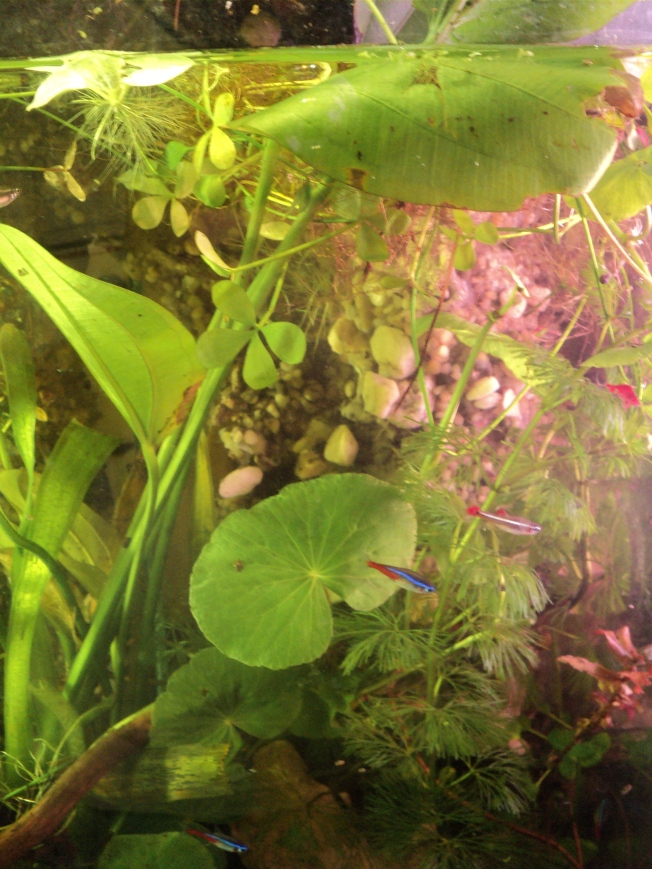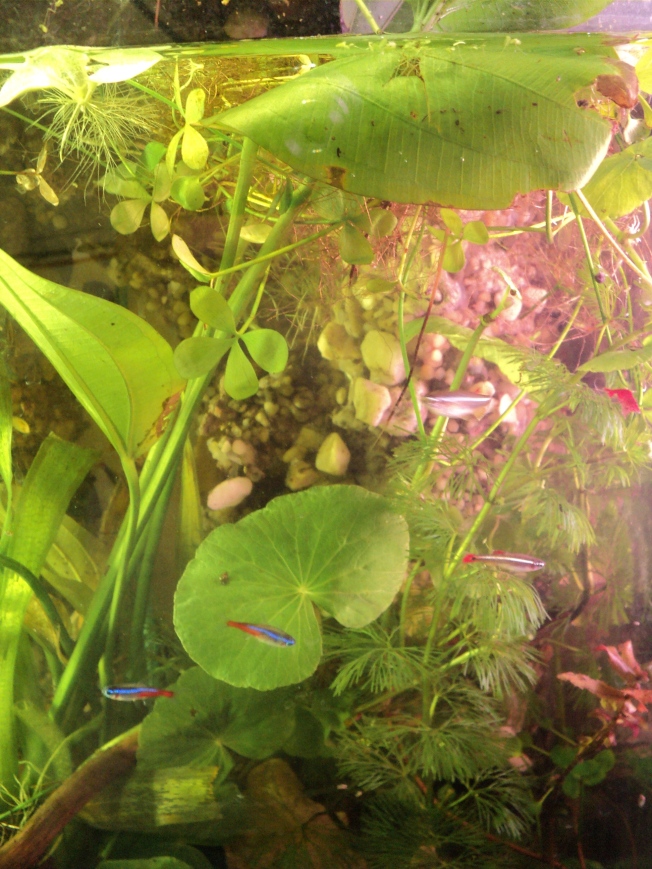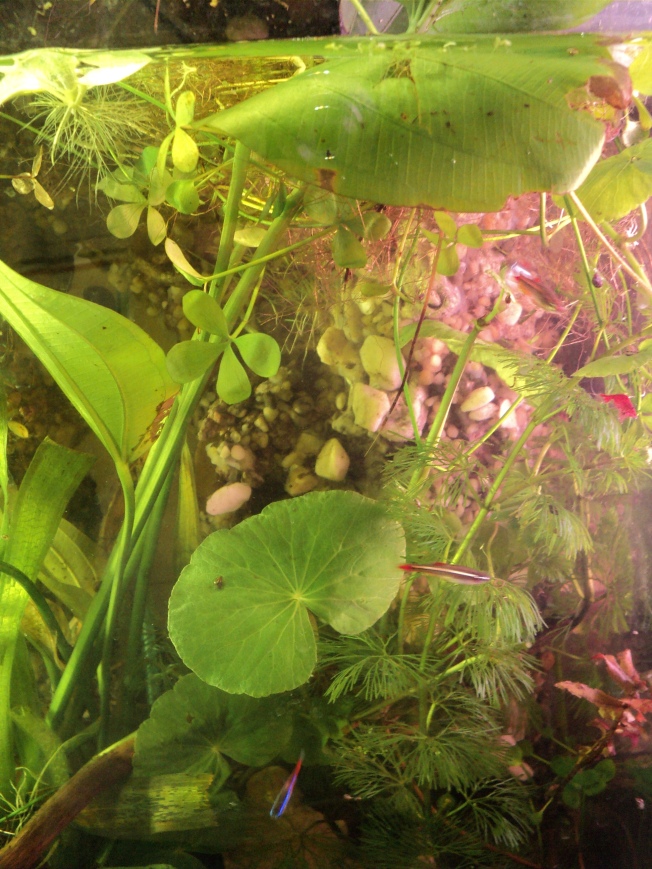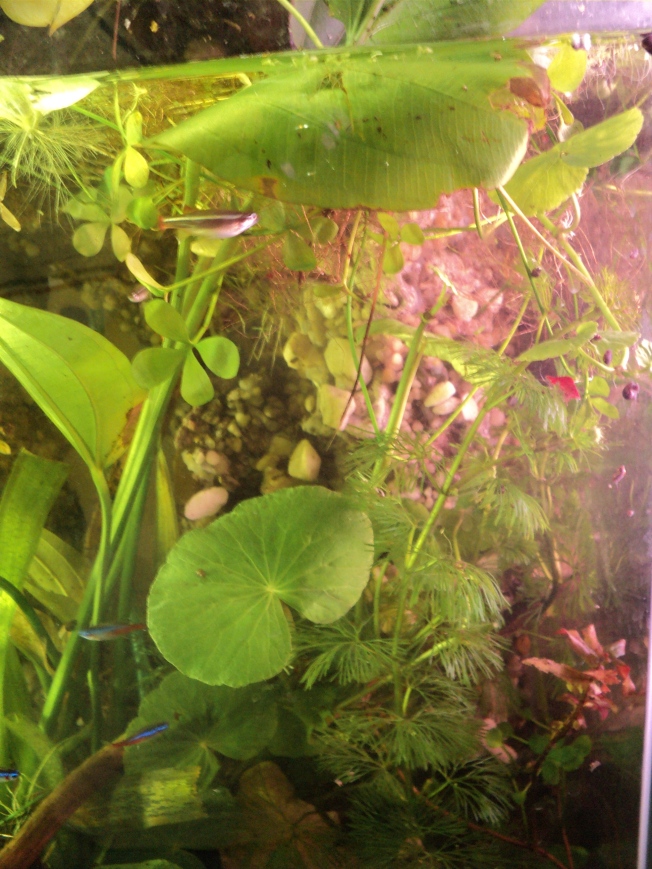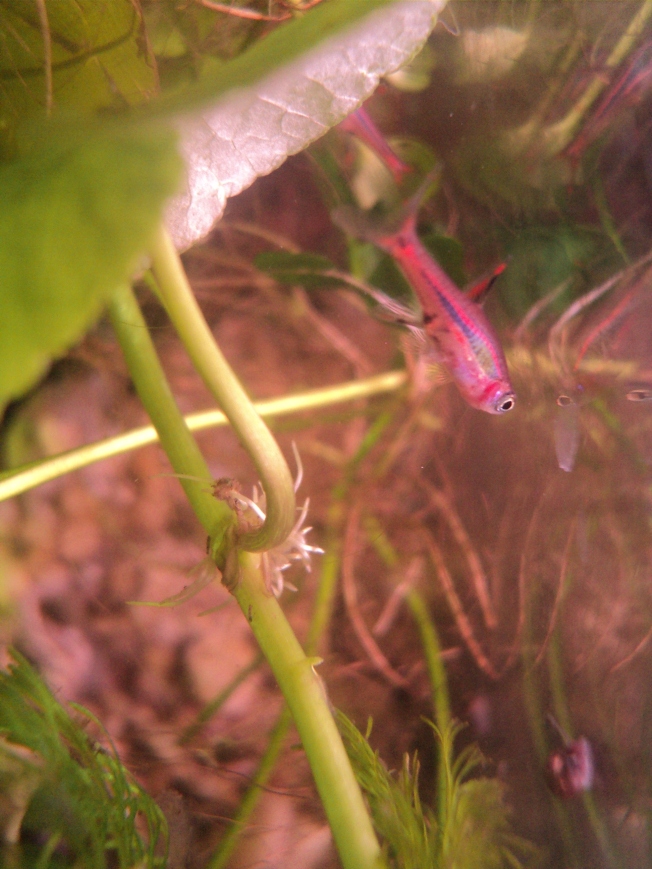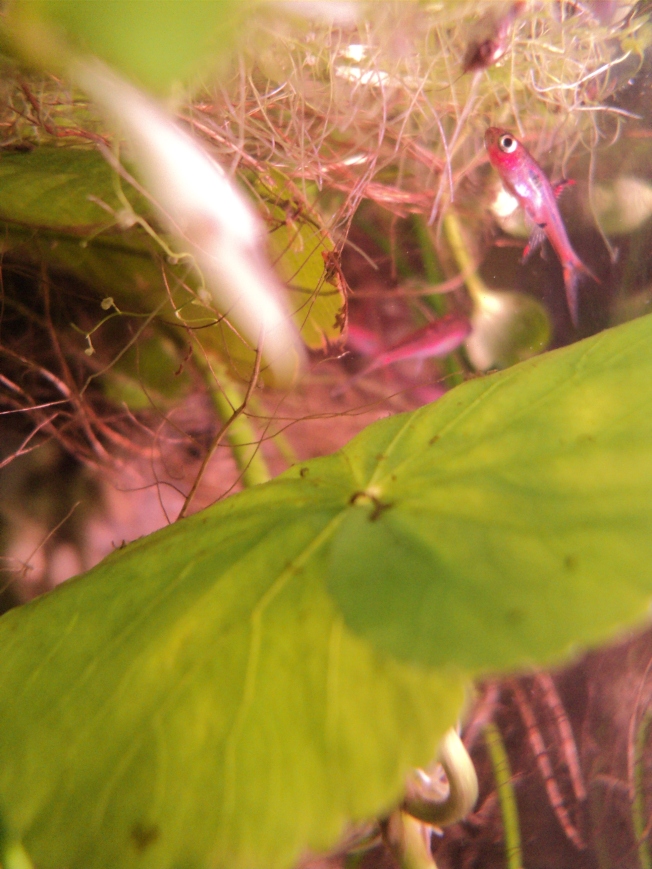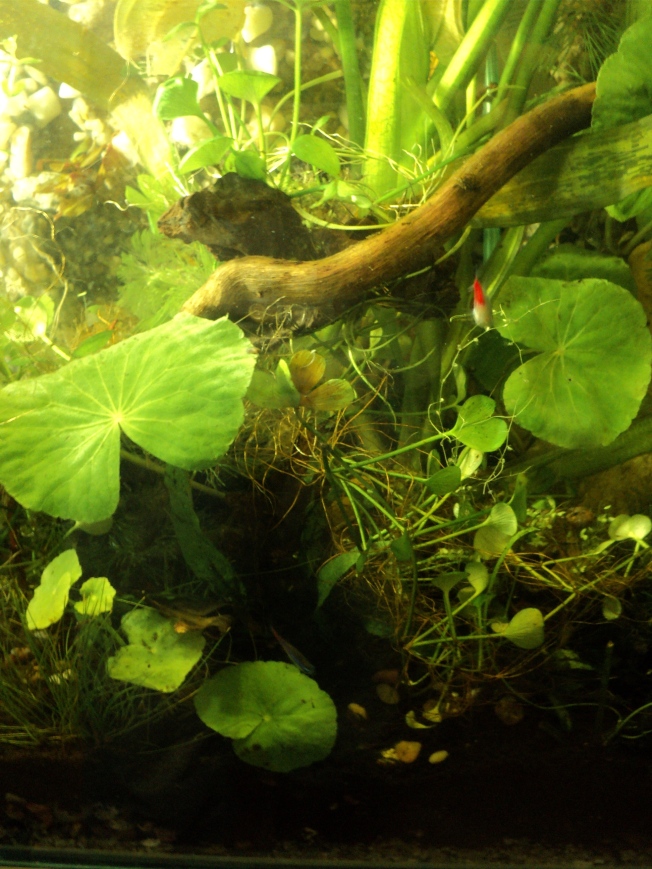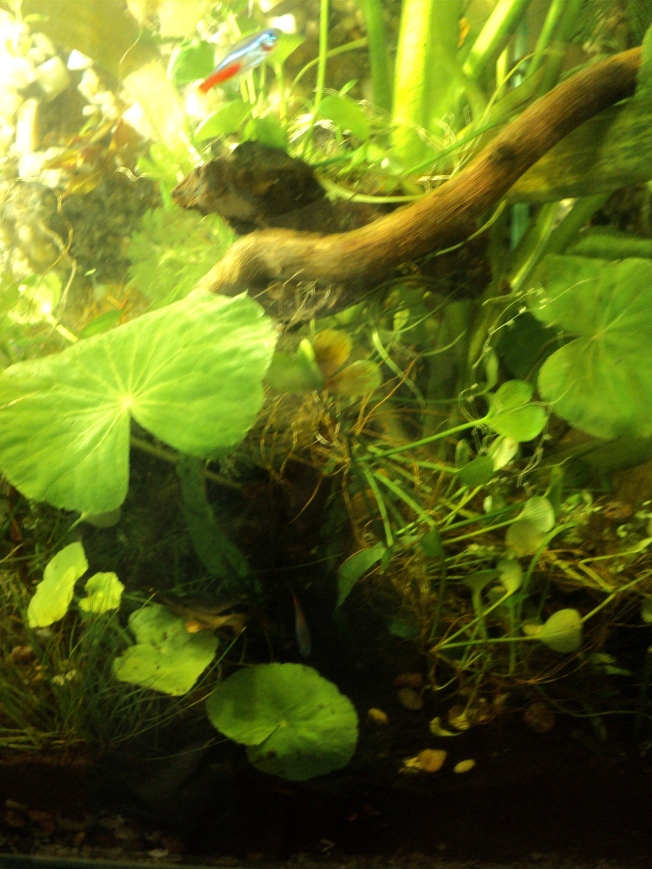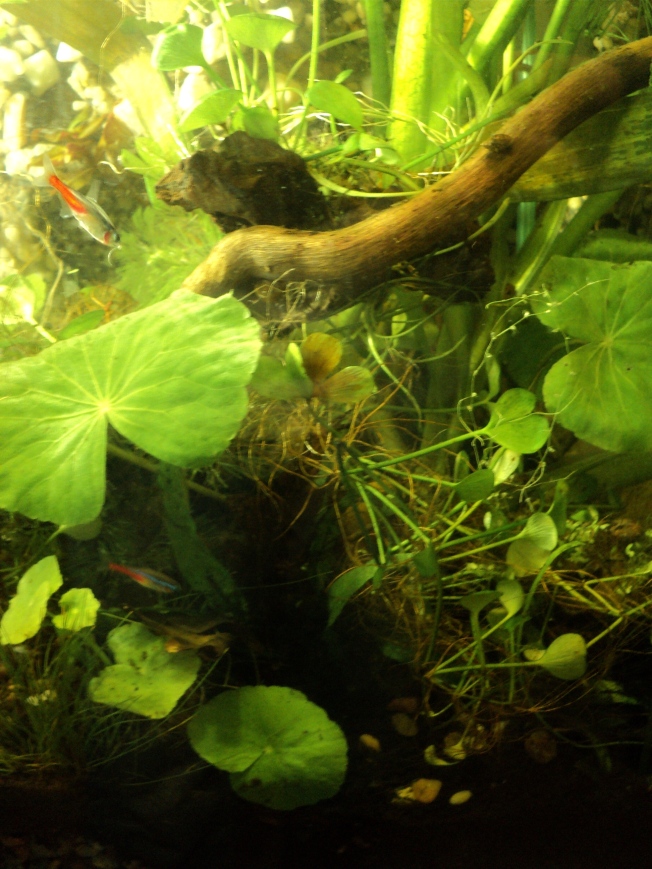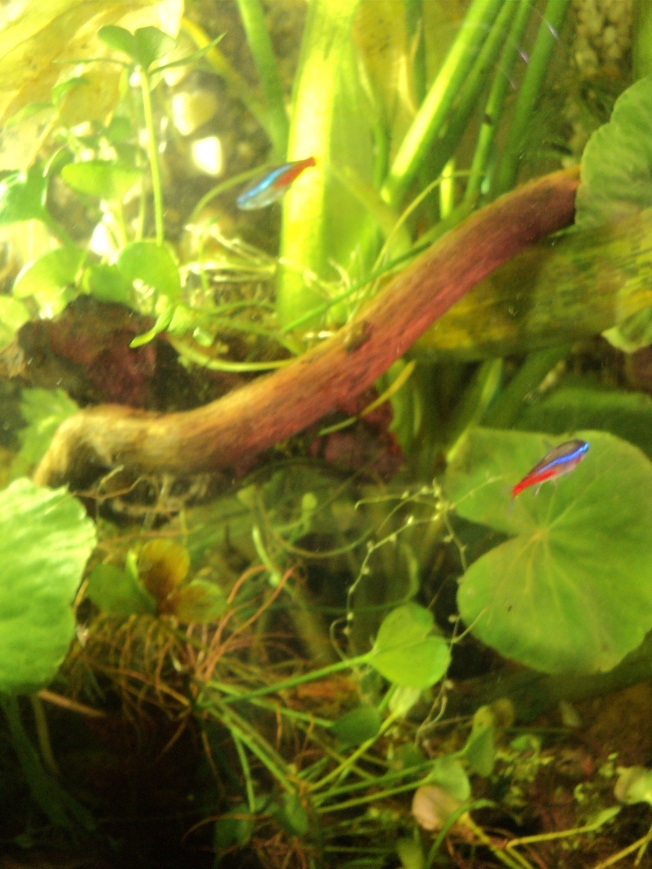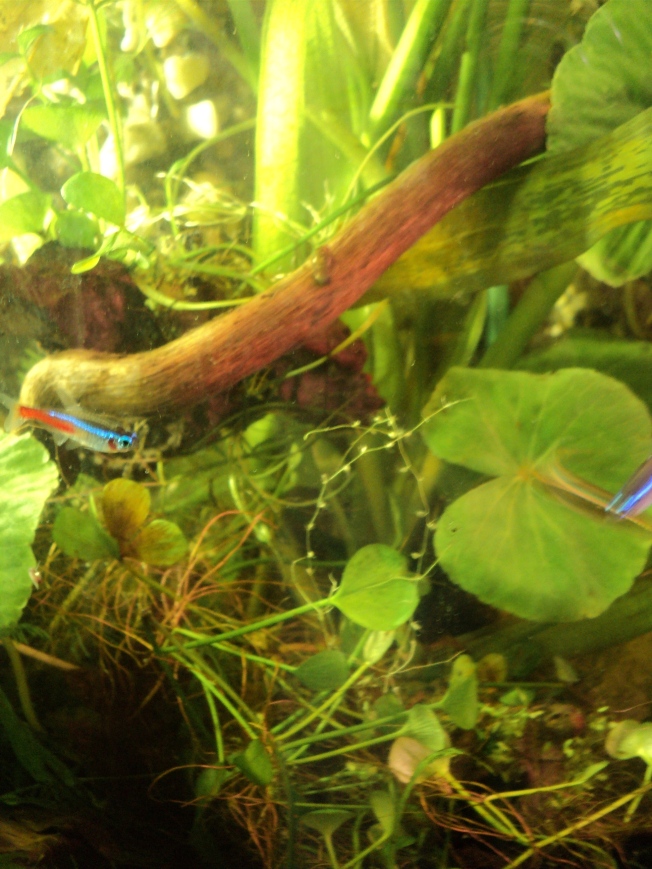Hier on a découvert un nouveau magasin de poissons et vipères en tout genre très intéressant au pied d’HLM. C’est de loin la plus chouette de toutes les maisons à poissons (sur plus d’une demi-douzaine que j’ai visités ces dernières semaines). Attila a choisi des guppies, 4 dont un a été offert, une femelle et trois mâles. J’ai demandé une femelle guppy d’une espèce différente des mâles ; la femelle est assez petite et presque aussi belles que les mâles de l’espèce qui n’est qu’un mélange de panachés noirs et qui forment dans le bac de 60 litres carré un groupe d’une centaine et avec les femelles on a l’impression d’une sorte de kaleidoscope très peu coloré mais beau. Le mâle en cadeau est le plus petit presque sans couleur, les deux autres mâles sont tous de l’espèce dite “guppy sauvage” caractérisée par un picasso orange, jaune, noir et blanc sur le corp et la queue (cas du second mâle) enfin j’ai choisi le seul mâle du groupe qui soit jaune orangé vif avec des tâches blanches et orange sombre sur tout le corps et la queue. Ils sont impossibles à photographier tant ils sont agités comme le montrent ces quelques nouvelles photos du riparium…
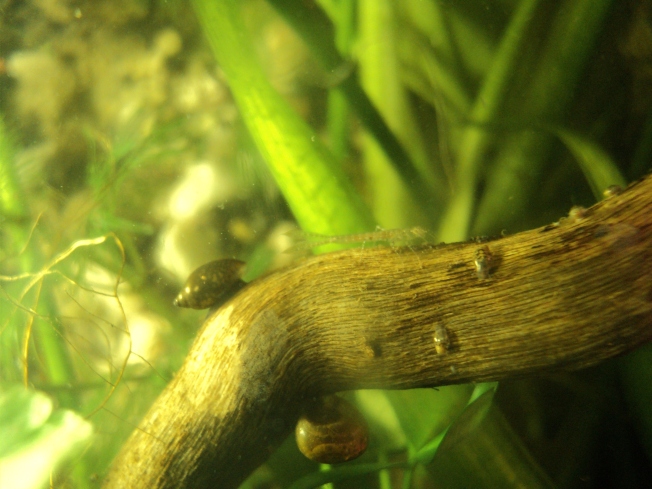
Hier matin j’ai éclairé soudainement la lumière et j’ai surpris une larve de demoiselle déjà entrevue il y a deux semaines mais elle a doublé de volume (j’ai lu que la chaleur de l’eau accélère leur croissance ce qui me permettra de m’en débarrasser plus vite) elle mesurait à peine 6 mm lors de l’introduction de mes premières plantes ; aujourd’hui elle fait plus de 2 cm! Dangereuse pour les alevins j’espère la capturer un jour et aussi j’espère qu’elle ne s’attaquera pas à mes brigittae chéris…

Mes brigittae ne sont donc plus que 5, à moins qu’un se cache toujours… le riparium est plein de cachettes.
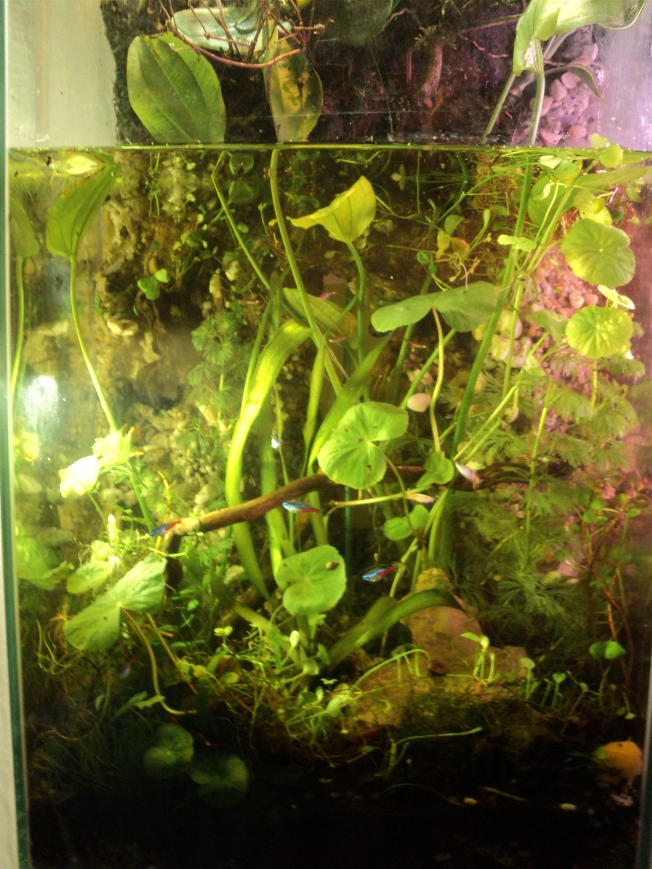
Hier j’ai passé plus de deux heures très tôt le matin à jardiner avec mon nouveau ciseau reçu avant-hier… Cette multitude de plantes grâce à l’acquisition de la dernière plante-trèfle qui comportait une dizaine d’autres plantes dans ses racines est bien ce qui me plait le plus dans ce riparium et il faudra que je fasse comme un herbier du riparium un de ces jours…

ce matin les deux femelles grillon sont mortes à cause de champignons filandreux qui en deux jours ont envahi leur sachet plastique. Le mâle hier soir a entoner un chant du cygne d’une heure devant la femelle mais je ne me suis pas aperçu des champignons qui l’ont tuée cette nuit. J’attend que leurs oeufs éclosent d’un jour à l’autre pour renouveller les deux femelles (ou trois) avec un mâle de plus (soit quatre larves maintenue en vie pendant sept semaines, leur maturité)

Les plantes du mur du riparium continuent d’être aspergées régulièrement, en plus du goutte-à -goutte (qui dure des heures, une fois par jour…
les plantes du mur se portent relativement bien : le lierre ficus s’asséchait mais j’ai réajusté le petit pot de terre à l’arrière, le “palmier” en haut à droite perd des feuilles et les renouvelle tous les 2 ou trois jours, les autres plantes y compris les deux orchidées continuent à végéter seule le phylandrium fait des racines blanches qui vont atteindre l’eau du riparium qui se trouve à 20 cm en bas…
J’ai aussi trouvé deux crevettes hier. L’une d’elles est “transparente”. J’essaie de voir pourquoi : voici deux réponses possibles…
http://www.planetinverts.com/Amano%20Shrimp.html
Amano Shrimp
Caridina multidentata
Overview
The Amano Shrimp is a very popular shrimp in the hobby. It is second in popularity to the Red Cherry Shrimp. The name Amano Shrimp originates from the well known aquarist Takashi Amano who frequently uses the shrimp in his aquariums as algae eaters. However most people do not know that the Amano Shrimp is a difficult shrimp to breed and that virtually all Amano Shrimp are caught in the wild and then sold to hobbyists. Captive breeding has been achieved but is rare.
Popularity
As stated above the popularity originated from the aquarist Takashi Amano. Most local fish stores carry this shrimp and even the large pet chains carry it as well. Hobbyists sometimes begin with this species to due the ease of acquiring it. The notion that it is a superb algae eater also attracts aquarists who are into planted tanks. Unfortunately most of the hobbyists who acquire the Amano Shrimp do not know that it cannot be bred in freshwater and wonder why the pregnant females with many eggs never produce babies.
Deaths
It is not uncommon for the Amano Shrimp to die shortly after introduction to the aquarium. Virtually all Amano Shrimp are wild caught and are not used to captive conditions. Also, a lack of feeding can cause death as well. Most first timers keeping these shrimp think that they are solely algae eaters and can live off of the tank and require no food. You must feed this shrimp. Deaths are also caused by stress from shipping, handling, lack of acclimation to new conditions and from being introduced to multiple tank parameters. Remember that the Amano Shrimp is caught in the wild. It goes through a lot of stress during capture and during shipping around the world. Once it reaches the local fish stores it undergoes even more stress. When it ultimately ends up in the hobbyists tank it can be marked for death regardless of what the hobbyist does to keep it alive. Do not be surprised if this shrimp dies on you shortly after introduction.
Breeding
As stated before the Amano Shrimp requires brackish water in order to breed successfully. The pregnant females carry many eggs, most likely due to the loss rate of the larvae after hatching. The shrimp hatches as a tiny larvae free floating in the water. It is not like other shrimp which hatch as miniature adults. The larvae are very delicate and require special care. Below is a quick run down on information required to breed this species in captivity. It is a difficult task to captive breed the Amano Shrimp. However, if you are up for the challenge then good luck. It is definitely an achievement if you are successful!
Captive Breeding
The adults are kept in a 40 gallon ‘breeder’ tank with a sponge filter and lots of hornwort. The pH is close to neutral and the temperature around 75 degrees F. They eat ‘GP Pellets’ plus the occasional algae tablet — there’s also a lot of hair algae in the tank, more than they can keep up with.

Larvae are raised in full-strength (35 ppt) seawater that’s pea-green with Tetraselmis algae. No supplemental foods are added. The latest batch was raised in a 2.5-gallon tank — there was somewhat high mortality, so more space may’ve been helpful.
I’ve tried a variety of raising conditions. So far, the best results are with:
24-hour lighting
Gentle aeration
mid-70’s Farenheit
In those conditions the larvae began metamorphosing into postlarvae after about 20 days. Higher temperatures seem to slow development. It took just about 6 months for a full life-cycle from hatching to egg production.
Feeding
It is recommended that the Amano Shrimp be fed like any other shrimp in the hobby. Using this species solely for the purpose of algae eating will not suffice in the long term for the shrimps health. These are rather large shrimp and require a good supply of food. They eat anything from blanched spinach, zucchini, algae wafers, shrimp pellets, fish flakes, bloodworms, and more. Feeding is best done once a day. Only feed an amount of food that the shrimp can finish within 2-3 hours maximum. It is not good to feed in excess and have food sitting for too long.
Additional Photos
http://www.planetinverts.com/Neocaridina_Heteropoda.html
Neocaridina Heteropoda
Neocaridina heteropoda “wild”
Overview
The Neocaridina Heteropoda species is the wild-type invertebrate of the common Red Cherry Shrimp and Yellow Shrimp. Both of the species were selectively bred from this wild-type in order to obtain their solid red and solid yellow coloration. This is the original Red Cherry Shrimp and Yellow Shrimp quite simply.
Background
The Neocaridina Heteropoda is found in Asia, its exact location is unknown. This wild species has been used by hobbyists to selectively breed color morphs, such as the Red Cherry Shrimp and Yellow Shrimp. If you look closely at each of the photos you can see some coloration of either yellow or red. Selective breeding is done by taking the characteristics, in this case coloration, and breed the wild shrimp that exhibit that color over many times. Eventually a solid color is developed after several generations. This must be a very difficult task. The exact amount of generations that it took for the Red Cherry Shrimp and Yellow Shrimp to become fully colored is unknown.
Water Parameters
The Neocaridina Heteropoda Shrimp can be housed in many different water parameters. Just like the Red Cherry Shrimp, this species can be kept in a pH range from 6.0 to 8.0, soft and hard water, temperatures from 72F to 84F and in many different soils like ADA Aquasoil and normal gravel. When following water parameters for this species it may be best just to refer back to the parameters of the Red Cherry Shrimp species if you have successfully kept it.
Breeding
The Neocaridina Heteropoda Shrimp is extremely prolific, just like its red colored cousing, and will breed readily and virtually around the clock. Clean water and proper water parameters will ensure that this species breeds constantly. Females will have green colored eggs when pregnant. The saddle will also be green and the appearance of a saddle while there are eggs is a good sign that hatching is days away.
It is typically 30-45 days from pregnancy to hatching. Another way to tell is by the emergence of a new saddle when the female still has eggs. The emergence of the saddle is the indication that the female is prepared to have a new set of eggs and that the current eggs are close to hatching. For more information on the reproduction cycle of freshwater aquarium shrimp please read the article Shrimp Reproduction.
Male attempting to mate with a female
Feeding
The Neocaridina Heteropoda will eat anything from blanched spinach, zucchini, algae wafers, shrimp pellets, fish flakes, bloodworms, and more. Feeding is best done once a day. Only feed an amount of food that the shrimp can finish within 2-3 hours maximum. It is not good to feed in excess and have food sitting for too long. Overfeeding is a known cause of death and can also cause water quality issues. Remember that shrimp are scavengers in the wild. They will eat whatever they find and are not used to a constant food source 24/7. Not feeding for one or two days is fine and will not harm this species at all. Sometimes I will not feed for a couple of days in order to let the shrimp cleanse their systems and keep the water clean at the same time.
Sexing
Sexing the Neocaridina Heteropoda is not difficult at all. Females are easy to identify as they are larger than the males, have a much darker coloration, and also have a curved underbelly. Females will also have a saddle or even have eggs. In the photo below you can see how the female Neocaridina Heteropoda has a green saddle and also has the tell tale curved underbelly.
Female Neocaridina Heteropoda
In the photo below you can see how the male is smaller, has very little coloration and the “under belly” is a straight line with no curved shape.
Male Neocaridina Heteropoda
Coloration
This wild-type variety has a camoflauged coloration to it to obviously help it hide in the wild. If you look at the first photo below you will see how well the two females are able to blend in with the rock. Such a scattered coloration must make it extremely difficult to selectively breed out and fill a new variety with solid coloration. However, some breeders of this species have noted that some of the offspring will show a somewhat red coloration and perhaps this is where the Red Cherry Shrimp idea began. Please see a photo below of two females on a rock.
Two Female Neocaridina Heteropoda
Je penche pour la deuxième solution. D’ailleurs la photo est plus proche de ma crevette (pas de point bruns comme a l’amano) et le vendeur disait qu’il s’agissait d’un mâle red cherry. Ci-dessous des photos qui datent d’avant les guppies et deux nouvelles crevettes (3 à 5 jours plus tôt) :
Enfin voilà le plus sûr moyen d’identifier mâle et femelle entre vos crevettes. Mais moi j’hésite encore. Seule la transparente semble être possiblement un mâle et encore ça reste à prouver…
Freshwater Aquarium Shrimp Reproduction
An explanation of the reproduction process
Overview
The Freshwater Aquarium Shrimp has a unique reproduction process of which some aspects are unknown. What is known can sometimes be skewed or misunderstood. This article is meant to try and fully explain as much as possible the reproduction process of the Freshwater Aquarium Shrimp. This article is meant to explain the process for shrimp which do not have a larval stage during reproduction. This article pertains to those species which produce miniature adults directly from the egg during reproduction.
Sexing
Of course when attempting to understand the reproduction process one of the most important aspects is the ability to sex the shrimp. However, this is not that easy. Some species are very easy to sex whereas others are virtually impossible to sex with what is known now. Species such as the Red Cherry Shrimp, Yellow Shrimp, Snowball Shrimp and a others are very easy to sex. Other species such as the Red Goldflake Shrimp, Cardinal Shrimp, Harlequin Shrimp and others can be extremely difficult to sex. Sexing really does depend on the species you are observing. Check out each species info page to read the detailed information on that particular species and how to sex it.
Age: Sexing of course depends on the age. Trying to sex adults is a lot easier than attempting to sex juvenile shrimp. Juvenile shrimp can be very difficult to sex, sometimes impossible depending on the size and species. Sexing sub-juvinile shrimp will most likely be impossible due to the fact that the shrimp is not old enough to display any gender identifying attributes, etc. It is definitely a good idea to only attempt to sex adults.
Size & Coloration: With many species the female is typically larger than the male. Also, the female is sometimes darker or more robust in coloration. As with the Red Cherry Shrimp, the female is not only larger but a much darker red coloration. The male Red Cherry Shrimp is instead almost colorless at times and much smaller. Females of some species may also display a line down their backs. Below is a photo of two Red Cherry Shrimp, one male and one female. Notice the size difference and more importantly the difference in coloration.
Male and Female Red Cherry Shrimp
Gender Attributes: There are also other methods to easily sex a shrimp. Certain identifiers, or attributes, can differentiate a male from a female without question. These attributes typically involve the female and certain aspects of her anatomy that do not appear in males. Some of these attributes also occur at certain periods whereas some with appear at all times. Of course a female currently holding eggs will tell you that it is indeed a female. However, when eggs are not present there are other ways to tell.
The “Saddle”: Once of the most common and distinguishable attributes is the appearance of a “saddle” or miniature undeveloped eggs in the ovaries. The term “saddle” comes from the fact that that the undeveloped eggs appear on the back of the shrimp, behind the head, which looks like the saddle on a horse. Below is a photo of the Yellow Shrimp with both eggs as well as a “saddle”. Notice in the first photo how the “saddle” actually looks like a real saddle you would find on a horse. In the second photo notice the tiny undeveloped eggs that actually make up the “saddle”.
Yellow Shrimp with Eggs and Saddle
Curved Underbelly: Another way to tell the difference between a male and a female is the appearance of a curved underbelly, or the region underneath the tail. When the female is pregnant the underbelly acts as a defense against potential damage to the eggs. The curved underbelly appears in females of many species of shrimp but there are some species which do not possess this characteristic regardless of sex. The lack of an underbelly does not necessarily mean that the shrimp is a male. It really depends on age and more importantly the species of shrimp in question. Below is a photo of a Crystal Red Shrimp Female with a distinctive curved underbelly.
Crystal Red Shrimp Female with curved underbelly
Mating
The “Act”: Mating between a male and female shrimp happens extremely fast. In a matter of seconds the male latches onto the female abdomen to abdomen, deposits his sperm, and quickly then releases the female. Sometimes you can actually observe a male constantly harrassing a female in an attempt to grab onto her. Next time you think that the shrimp are fighting it may be a male trying to mate instead. Below are a couple of photos of a male Red Cherry Shrimp latched onto a female and depositing sperm.
Red Cherry Shrimp Male on Female by Peter Maguire
Red Cherry Shrimp Male on Female by Peter Maguire
Fertilization: As discussed earlier in the article the female contains tiny undeveloped eggs in the ovaries, also known as the “saddle”. The male deposits the sperm into the female before the eggs are passed from the ovaries and into the undercarriage. As the eggs are passed down into the undercarriage they become fertilized by the previously deposited sperm. There is a big misconception that the eggs are fertilized after they appear in the undercarriage which is untrue. You will not see a female mate if eggs are present, you will only see a female mate when eggs are not present. It is believed that the male has a tiny “appendage” that it uses to deposit the sperm into the female. Below is a photo of the “appendage” as well as a zoomed photo.
Male Red Cherry Shrimp Appendage by Peter Maguire
Male Red Cherry Shrimp Appendage Zoomed by Peter Maguire
Unknowns: There are many unknowns as to the exact science behind the mating process. It is believed that shortly after molting the female is ready to mate. The way in which the male knows that the female is ready to mate is unknown. Perhaps she releases a chemical signal or some other type of notification that only shrimp can detect. It is known though that when a female molts the males in the tank will swim around the tank in a drunken manner looking to find the ready female. When you see a bunch of shrimp swimming around in the tank against the glass make sure to sex the shrimp first. If you look closely you may notice that they are all males. If that is the case then everything is ok, they are just looking to mate.
